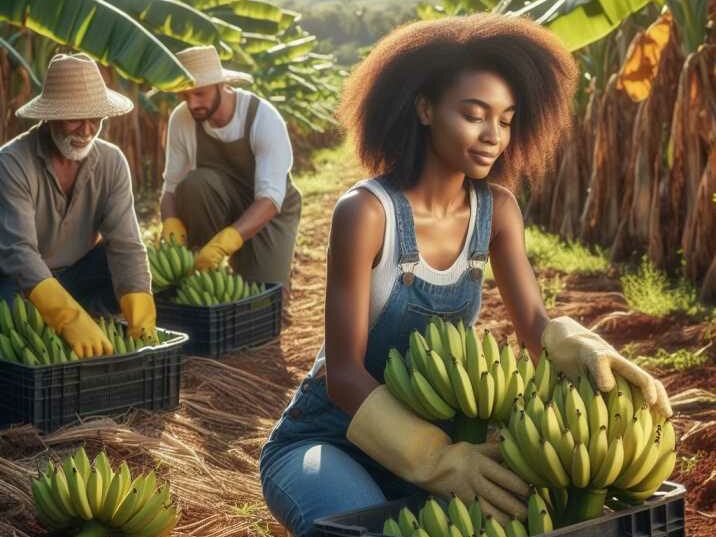Introduction:
Table of Contents
Cavendish bananas are a household favorite across the globe, loved for their sweet taste and versatility in culinary delights. But have you ever wondered where these beloved bananas predominantly grow? In this comprehensive guide, we’ll journey through the key growing regions of Cavendish bananas, uncovering fascinating insights into their cultivation practices and the factors that make these regions ideal for banana production.

Key Growing Regions of Cavendish Bananas:
- Latin America: The Heartland of Cavendish Banana Production
- Latin America reigns supreme as the primary region for Cavendish banana cultivation, with countries like Ecuador, Costa Rica, and Colombia leading the charge. The tropical climate, fertile soils, and ample rainfall in these regions create the perfect environment for banana plantations to thrive.
- Fun Fact: Ecuador is the world’s largest exporter of Cavendish bananas, accounting for a significant portion of global banana trade.
- Southeast Asia: A Haven for Banana Plantations
- Southeast Asia, encompassing countries such as the Philippines, Indonesia, and Thailand, boasts favorable conditions for Cavendish banana cultivation. The warm, humid climate and well-drained soils provide an optimal setting for banana growth.
- Tip: The Philippines is renowned for its premium-quality Cavendish bananas, prized for their taste and texture.
- Africa: Emerging as a Promising Banana Producer
- Countries in Africa, including Cameroon, Ghana, and Ivory Coast, are emerging as key players in Cavendish banana production. The tropical climate and abundant sunshine in these regions support the growth of healthy banana plants.
- Insight: Ivory Coast has been making strides in banana cultivation, with investments in modern farming techniques to enhance productivity and quality.
- Australia: Nurturing Cavendish Bananas Down Under
- Australia, particularly the tropical regions of Queensland and New South Wales, serves as a notable Cavendish banana growing region. The warm, subtropical climate and fertile soils contribute to the success of banana plantations in these areas.
- Fact: The Cavendish variety dominates banana cultivation in Australia, favored for its resistance to Panama disease, a common banana plant ailment.
- Central America: Diverse Banana Plantations Flourish
- Central American countries like Guatemala, Honduras, and Panama are key players in Cavendish banana production, benefiting from their tropical climate and rich volcanic soils. These countries have a long-standing tradition of banana cultivation, dating back to the early 20th century.
- Tip: Guatemala is renowned for its high-quality Cavendish bananas, exported to various parts of the world.
Insights into Cavendish Banana Cultivation:
- Cavendish bananas thrive in tropical and subtropical climates with temperatures ranging from 15°C to 35°C (59°F to 95°F). They require ample sunlight and well-drained, fertile soils for optimal growth.
- The cultivation of Cavendish bananas involves meticulous care, including regular irrigation, fertilization, and pest management. Banana plants are vulnerable to pests and diseases, necessitating proactive measures to ensure healthy yields.
- Sustainable farming practices, such as integrated pest management and soil conservation techniques, are crucial for maintaining the long-term viability of banana plantations and preserving environmental integrity.
- Harvesting Cavendish bananas at the right stage of ripeness is essential to preserve their flavor and nutritional value. Bananas are typically harvested when they reach a mature green stage and ripened off the plant using ethylene gas.
Conclusion:
Growing Regions of Cavendish Bananas, From the lush plantations of Latin America to the tropical landscapes of Southeast Asia and beyond, Cavendish bananas find their home in diverse regions across the globe. Understanding the key growing regions and cultivation practices sheds light on the journey of these beloved fruits from farm to table. Whether enjoyed fresh, blended into smoothies, or baked into delicious treats, Cavendish bananas continue to delight palates worldwide, thanks to the dedication of farmers and the ideal growing conditions in their respective regions.
FAQs:
- What is the optimal climate for growing Cavendish bananas?
- Cavendish bananas thrive in tropical and subtropical climates with temperatures ranging from 15°C to 35°C (59°F to 95°F) and ample sunlight.
- How are Cavendish bananas harvested?
- Cavendish bananas are typically harvested when they reach a mature green stage and ripened off the plant using ethylene gas to preserve their flavor and quality.
- Which country is the largest exporter of Cavendish bananas?
- Ecuador holds the title of the largest exporter of Cavendish bananas, accounting for a significant portion of global banana trade.
- Are there any notable pests or diseases affecting Cavendish banana plants?
- Yes, Cavendish banana plants are vulnerable to pests and diseases such as Panama disease and banana weevils, requiring proactive pest management measures for healthy yields.
- How do sustainable farming practices contribute to Cavendish banana cultivation?
- Sustainable farming practices, including integrated pest management and soil conservation techniques, play a crucial role in maintaining the long-term viability of banana plantations and preserving environmental integrity.
